1st Febuary 2012 - 1st March 2012, On to mainland Asia
Johor Bahru - Pontian Kecil - Benut - Melaka
Total distance: 2000 - 2179.8km
Truly Asia
According to their tourism board, Malaysia is "Truly Asia" a phrase that might not entice too many people to come cycling touring here. To us at least, "Truly Asia" conjures up terrifying images of distracted bus drivers hurtling around potholed mountain passes, or fume-choked roads clogged with rickshaws, motorbikes, and water buffalo; just about the worst conditions any cyclist could ever imagine. So, what is Malaysia actually like on a bike, who for that matter are the Malays, and where, for heaven's sake, is the goat? Explanations are in order. So, cycling up mainland Asia. It goes a little somethin' like this...
 |
| Crossing the causeway |
There was a lot of space around us now too, we had a strong sense of that as soon as we got out of customs. The quiet main road out of Johor Bahru went straight on and on with only a smattering of old buildings lining its flanks. Beyond the road there were just great tracts of rippled wasteland, with rusting hulks of ships nestled among the clumps of grass. This sense of openness served to energise us, like spending all morning in a luxurious hotel room, then stepping outside to find it's a glorious day.
 |
| Johor Bahru |
Our good friend Rah had given us some directions to Pontian Kecil, a small town over on the west coast where he thought we should be able to pitch a tent. The temperature steadily rose as we rode, until the air was scorchingly hot, but apart from that the road conditions remained ideal. They were perfectly flat, well maintained, and we even had our own bike lane. Malaysian roads actually have a designated motorbike lane you see, like a hard shoulder running along the left-hand side, but all the motorcyclists prefer to ride with the big boys in the central lanes, leaving this wide lane completely clear for us. The smothering heat hung to our shoulders, we pedalled, and the day rolled by. Back on the road then, once again.
Malaysian drivers have something of a bad reputation in Singapore. Everytime we told someone we were going to be cycling here they became very serious for a moment and told us to be especially careful. After the warnings about Javanese traffic, then Jakartan traffic, all of which turned out to be fine, we were fairly dismissive of these warnings. Malaysia and Singapore don't get on especially well, and we figured that these rumours were probably just a continuation of that. However, our first day riding yielded a near collision that seemed to justify the concerns.
We were cruising along at about 25kmph when a small car overtook us. Just after the car had overtaken Liv it turned left, right in front of her and without indicating. Liv had to slam her brakes on so hard that her back wheel with its 15kg of panniers reared right up off the road. She missed the car by a few inches, and it was remarkable that she managed to keep the bike upright and not fall off in the process. It was a very close call. The perpetrator was a meek Muslim lady in a pink headscarf, who was profusely apologetic. She had, however, been an abominably bad driver. We didn't know how to say this in Malay, so we just shouted at her in English for a few minutes until she drove away. Afterwards we felt a bit bad for shouting at her so much, but it was the worst bit of driving we've come across so far by quite a long way.

Thankfully though, she was the exception. Apart from that one incident the drivers have all been extremely courteous and careful here, more so than anywhere else we have been, and combined with the roomy roads and (motor)cycle lanes, Malaysia has been a very pleasant experience indeed.
We arrived in the quiet beach town of Pontian Kecil just as the sun was going down, and asked one of the restaurant owners if we could pitch a tent on the grass outside. They not only agreed but after we ate dinner there that night they insisted it was on the house, to welcome us to the country. Now, I don't know how many of you reading this have ever been given a free meal by a complete stranger, but I can tell you it is a very heart warming thing indeed. It succeeded in cheering our mood no end after the close call earlier in the day.
To stop us from getting too comfortable though a friendly team of street dogs came by that night and barked loudly right outside our tent. We slept dreadfully, and the next morning it absolutely bucketed it down for six hours. That's more like it, truly Asia!
Where is the goat?
The next day we were struck by the Malay's incredible hospitality once again, as we pulled into a warung, hoping the owner would let us pitch a tent in the dirt behind his shop, and we found ourselves quite unexpectedly swept up into Malay family life for a series of unforgettable days.

It hadn't looked like we'd get very far that morning either. The rain had come very soon after we'd woken up and we were sat drinking coffee at a fast-food store just across the road when it started hammering it down. We were trapped then, in what was the Malaysian equivalent of a Little Chef for six hours while it poured outside. Thankfully it gave in at around 3pm, and so we escaped, hoping to get a few kilometres under our belts that day at least. With the flat, straight road conditions in Malaysia, nailing a fairly respectable distance in a couple of hours is perfectly plausible.
To backpackers, Malaysia is known as being that little bit more expensive than the rest of the South East Asian circuit, and perhaps even a bit less authentic as far as gap-year travelling goes. Certainly when I was first having a look at the region with backpacking in mind a couple of years ago, Malaysia was quickly disregarded since the suggested daily budget, even for cheap-o travellers, was considerably more than the rest of the countries around there. I imagined shiny new hotels nestled in a pedicured palm forest by a fake white sand beach - hardly the kind of place any self-respecting backpacker would want to go adventuring in.
Well, I'm pleased to report that I was very much mistaken. Food-wise Malaysia is more expensive than Indonesia, but that increase in price brings with it an enormous increase in options and quality, and on the road it's quite easy to find good meals for just a couple of dollars a head. Malaysia is slightly more expensive, but perfectly possible to do on a budget of about $15 a day if you're sharing a room, less if you take dorms.
As well as being doable on a budget, it is certainly not a sterile holiday resort either. Malaysia oozes character. Fishing villages were dotted all the way along the road as we pedalled north, with colourful wooden boats moored in the estuaries, nodding to us as we went by. Those fiery red Chinese temples made regular appearances too, with golden dragons clambering up the entrance pillars, and grinning goblins guarding the heavy gates. Warungs lay just off the road, tempting us with coffee, chai, rice, and bendy plastic chairs to rest our weary backsides on.
As the afternoon got on we asked at one of these warungs to see if they knew anywhere we could camp, but between our limited Malay and their limited English the implication that we wanted to pitch it in the wasteland behind them was lost, and we were directed up the road where it seemed there might be somewhere suitable further on.
If there was, we didn't find it, and so we decided to change tactic and nip off the main road and ride along the web of smaller lanes alongside it that connect the villages and plantations together. The riding was nice. In the space of a few seconds we went from being on a wide open main road, to chickering along narrow bumpy lanes surrounded by vegetation. The majority of the land was palm oil plantations; dinosauric fern like trees planted in ranks at regular intervals. There would be plenty of space to camp in there, but it was also obviously somebody's land, and we didn't want to just pitch a tent without asking because it would be rude, and also because there were signs dotted about with pictures of trespassers having shotguns pulled on them.
 |
| No, you can't pitch a tent here |
We realised a few days later where this confusion might have stemmed from. The word camping in Malaysian, is more often translated as "Perkhemahan" not "kemping" as our phrase book suggested. "Kemping" you see, sounds remarkably similar to the much more common word "kembing" which means goat. That look of startled confusion on the villagers' faces started to make a lot more sense with this in mind. Especially when combined with our actions of slapping the large black bag strapped to the back of our bikes, and pulling funny faces. "Where is the goat?" They must have thought we were proper mental.
Needless to say, our foray off road to find a campsite failed, and we returned to the main road as the evening was setting in. After a little while a warung appeared at the side of the road, and we pulled in and ordered a cup of tea and some dinner. We asked the owner if he would mind if we pitched the tent out the back that night, but he seemed doubtful: "Sure, you can camp if you want, but the ground is wet, and it gets flooded. I wouldn't do it if I were you."
The table next to us had overheard our conversation with the owner, and one of the men there beckoned me over. His name was Taufiq, he was a broad fellow, with a thin moustache and friendly eyes. He spoke neatly and to the point. "I hear you are looking for somewhere to stay, and I would like to offer you a place to camp in my garden, or, if you prefer, a bed inside my house."
We agreed, of course. So once we'd all eaten we followed his car up the road, and pulled in to the gravel driveway of his single storey gated Malay home. His family came out to meet us, his wife Zita and his two boys and two girls - aged between 18 months and twelve years. They helped us bring our things into their living room, and what a living room it was too! The floors throughout were made of creamy white tiles, giving the whole place a brilliant shine, the sofas were a delight to collapse on, and the walls were decorated with framed calligraphy and family photographs.
The Hashims were enormously open and hospitable to us, and they made us feel immediately comfortable and welcome. Taufiq and Zita spoke English fluently, and the kids were not far behind. This meant we were really able to engage with them, and the world of Malaysia was opened up to us. As we sat down an array of Malay sweets and biscuits appeared to compliment our tea, and we talked.
The lost empire
So, who exactly are the Malays? This was something that neither myself or Olivia really knew much about. Well, I'm pleased to report that their history and culture is so rich that despite several weeks of researching I still don't feel like I've got to grips with even the most basic of basic sketches. I shall endeavour though, dear reader, to elucidate a little of what I have learnt, because they have a cracking history, and are just the sort of kindly, generous and good-humoured people that everybody should be familiar with.
Rewind the clocks about a millennia and a half - go on, ah, back a bit more... there we go - and you will find a bunch of pretty sizeable empires kicking about in South East Asia. One of these should be familiar to anyone who's slung a backpack over their shoulder and headed out this way. They were the Khmers, who left us the expansive ruins of Angkor Wat. During the middle of the first millenium AD, where we now find ourselves, Angkor Wat was the centre of a vast kingdom, with tributaries all across Asia, and, I am told, with some of its richer denizens getting around on gold gilded goat carts. These guys knew how to get around in style.
Follow me down south though, passed Thailand, over Malaysia and on to Sumatra, and here we find another big empire bubbling away that is remembered as the Srivijaya Kingdom. Or rather, we re-remember it as the Srivijaya Kingdom, because everybody forgot about them until the 1920's when a Frenchman started poking around and rediscovered them. It was quite strange really that everyone should forget about them, as it seemed that they were enormously influential and powerful in the region, and in fact their influence is still felt today.
Unlike the Khmers at the mouth of the Mekong, the Srivijayas did not have a great deal of fertile land to work with, and so they turned their attention to trade. They were lucky, for although the land they inhabited was absolutely tank as far as cultivation went, they were based right alongside the maritime silk route that had been used by ships trading goods between China and India since about the 1st century AD. Srivijaya were making the very best of this; taking a little fee from each vessel that passed, and gathering up the bits of valuable produce from all around their lands to trade with. They had a lot of land to harvest too. At their peak they spread themselves from Sumatra, all the way up to Cambodia, and east across much of Java as well as holding parts of Borneo and the Philippines. I will cheat a bit, and start my pop history of Malays right here, because this empire is a pretty big and exciting place to start, and this empire was a Malayan empire.
Actually, I really am cheating a bit here since Srivijaya wasn't wholly a Malayan empire, but it incorporated the powerful Malayan Malayu empire into itself during the eight century. And actually I could, if I knew enough about it and you had plenty of time on your hands, try to take you further back. There is talk of Proto-Malays and Deutro-Malays coming together from all over Asia. It gets very confusing you see.
So please forgive the simplification, but here they are, the Malays, mixed up in a mighty empire in around about the eighth century. If you want a taste of just how mighty they were, flick back to our pictures of Borobudur. This whopping monument to Buddhism was built by the eastern arm of the Srivijayas. As well as showing just how much power they wielded, for it takes a lot of might to build something like that, it is also stands as pretty good evidence that these chaps had a penchant for Buddhism. They were world renowned for their knowledge and wisdom in this regard, and monks from far and wide came to study there. One of its more famous students, the 11th century monk Atisha went on to influence the course of Tibetan Buddhism, while many others praised its teachings and encouraged the devout to spend time there.
As well as being a magnet for Buddhism, and a force to spread it in the region, the impact of the Srivijayan empire can still be heard today all across Malaysia and Indonesia. Some scholars believe that the modern day language of Malaysian and Indonesian have their roots in the old tongue of the Srivijayan empire. This has allowed Liv and I to get by (most of the time) in Malaysia on the bits of Indonesian that we picked up while we were over there. The two languages, although distinct, remain remarkably similar even today. We could ask a Malaysian and an Indonesian "Di mana kemping?" and they'll both be equally confused.
So what happened to this empire? Where did it go, and why did everyone forget about it? I'm afraid that will have to wait. Too much history for one sitting.
We had only been sitting and chatting for an hour, but it was obvious that we were all getting along very well with each other. Taufiq and Zita were interested in the goings on of England, which we were happy to tell them, and we were fascinated with all of these tales about ancient Malaysia. After a little while Taufiq asked us something quite out of the blue. How would we like to join them in attending a Malay wedding at the weekend? We glanced at each other, and it was obvious from our eager expressions that we both thought it was an amazing idea. Yes, we'd love too. We were both getting very tired though, owing to the chorus of hounds that had kept us awake the night before, so after accepting the invitation we turned in on the double mattress that had been prepared for us, and fell asleep.
Megafood
 |
| Preparing food |
 Malays are an exceptionally gregarious lot, and they spend much of their free time with family, or catching up with friends. When it comes to weddings though, their generosity and communal spirit goes supersize!
Malays are an exceptionally gregarious lot, and they spend much of their free time with family, or catching up with friends. When it comes to weddings though, their generosity and communal spirit goes supersize!Late one night Taufiq took us for a ride out of town to visit a group of people preparing the catering for a wedding the following day. There were several enormous pots, each one large enough to accommodate something around about the size of a car engine, and all around were ridiculous quantities of ingredients ready to go into the mix. Large trays covered in hand sliced garlic cloves, the fried meat of several hundred chickens, bags of rice, and ?quite a nice touch I thought ?just a splash of orange juice. They were cooking up a biriyani dish for a couple of thousand people, which would take over 24 hours to prepare. In Malaysia, you don't just invite your friends to your wedding, the whole town comes along!
It was a remarkable feat of logistics, and it took a whole team of them to bring it all together; some keeping an eye on the fire, others cutting ingredients, and several people tasked with stirring the pots with enormous wooden spoons that wouldn't have looked out of place on a rowing boat. We helped them too, with the tasting. It was delicious I tell you. They may have been making a preposterous amount of food, but they in no way scrimped on quality.
Palm Oil
As well as eating great food, and learning how they prepared it, we were shown around some of the agriculture of Johor to see where the ingredients came from. Pineapples are big in Malaysia, they were the biggest exporters of them for a time, and today you still see them in the emblems of townships, and even big plastic ones decorating town centres. Taufiq took us for a ride around to visit some pineapple plantations, and we were both amazed to discover that they don't grow on trees. Not a bit of it. They are short spiky plants, a bit like aloe-vera. When the time is right a little blob appears in the middle of them, that grows and grows until you find a pineapple suspended in a cactile imitation of Sideshow Bob's hair. Not what we expected at all.
 |
| Pineapples do not grow on trees |
The other big crop in Malaysia is palm oil. There are plantations everywhere. Ride for just an hour and the chances are you'll pass several long stretches of it. Palm oil is one of Malaysia's primary exports, and it's so important to their economy that it makes an appearance on the back of their 50 ringgit note.
It looks like the bastard child of a palm tree and a fern, and can grow up to 20 metres. At the top of these enormous plants are a bunch of reddish conker-like fruits that feel greasy to the touch, and sprout several times a year. It's from these that we get our palm oil. They are harvested, processed, and cheap multi-purpose vegetable oil is produced.
There is something very tragic going on with the palm oil industry though. I'm sure many of you will know a little about it, or, like me, will have had a vague notion that they are environmentally unsound.
 |
| Oil palm |
That is only a small part of the problem though. Indigenous tribes are being forced from their homes to make way for these trees, and many species of wildlife are having their habitat destroyed, and are themselves being pushed towards extinction. Tigers, orang utans and rhinoceros's all live in Malaysia, are all either endangered or critically endangered and their habitat is being knocked back at the rate of 68'000 hectares per year, much of this due to the palm oil industry.
What is especially depressing about palm oil though, is that it has been taken up as a viable alternative to petrol here in the West, with the intention of using it to help the environment. It's all to do with biofuels you see - burning plants and other biological matter to produce energy. Biofuels, like palm oil, emit far less carbon than traditional fossil fuels, and a lot of people got quite excited about using them in combination with, or as a replacement for, petrol and diesel to help us reduce the amount of carbon we're producing.
The problem with palm oil comes from the way that it is produced. As we've seen it's devastating forests, which would normally trap carbon for us and help us offset the carbon we're putting into the air. When the plantation owner wants to plant on peat though, things get really bad. In order to make the land usable he must invariably drain and burn it, and peat bogs trap an enormous amount of carbon inside them, which is released when it gets prepared for planting oil palms. This process releases tonnes of CO2 into the atmosphere, as well removing trees that would otherwise absorb it. It has been estimated that it would take 840 years to offset the carbon released with the lower carbon burn of peat-based palm oil bio-diesel. Put another way, this process creates almost as much CO2 as tar sands, and significantly more than crude oil. It's shocking, and it's not like these peat plantations are rare. We drove passed several in a single day, with Taufiq pointing out that the trees start sinking into the soil and don't last as long on the soft peaty ground.
Hopefully the Malaysian government will cotton on that they need to be working at making this potentially beneficial crop sustainable through regulation, although it may be some time because we and many other countries are happy to import it in its current state. In the mean time, keep an eye on what you're buying, because palm oil is everywhere, not just in bio-diesal. It's in bread, soap, margarine, cereals and chocolate. If you're interested in doing something about it, take a look at WWF's profile which shows which companies are sourcing palm oil responsibly. We live in a world dominated by the market - so it's the choices we make when we shop that will affect the outcome of this. Finally, chocolate lovers who are horrified to find that their favourite treat contains palm oil will be pleased to read that Cadbury's came out with top marks from WWF, so it is possible for big companies to do this thing right, and for you to keep guzzling chocolate.
Wedding
The days leading up to the wedding were busy ones, and the time flew by. Taufiq, Zita, and all the kids were incredible. Eager to show us their world, but allowing us time alone to rest and relax too. There are plenty of things we did that I haven't had time to go into here; we visited the most southerly point of mainland Asia, saw some (deceased) horse-shoe crabs, visited a museum, learnt about their religious practises, and were introduced to a litter of newborn bunnies. Really incredible stuff, and we feel very lucky to have bumped into such wonderful people.
Islam and Malay culture are very much entwined. Even during the Buddha-loving days of the Srivijaya kingdom there is evidence that they were interested in learning about Islam, which was brought to the area by the Arab traders that frequented the ports. Buddhism in the region gradually waned, along with the might of the empire, and by the 15th century Islam had become an integral part of the Malay identity. Nowadays in order to be officially considered Malay, a person must be a Muslim.
Liv was well versed in Islamic culture, having spent some time travelling through the middle east, but despite seeing plenty of mosques around Indonesia I had not really come up close and personal to this religion before. It was really nice to get a personal feel for it, see what it really meant for people and how it worked in practise. The recitals themselves reminded me somewhat of the solemnity of Sunday school, and I didn't understand the first thing that people were saying because it was all in Arabic. Apparently not all of the people there understood it either ?it's imperative that you learn to read Arabic, but not to understand its meaning. The recitals of Qu'ranic scripture are rightly famed for sounding very nice when read aloud though. There's a poetry that is discernible even if you can't translate the meaning. I must say as well, it's much more pleasant hearing this in a homely setting, gently recited by family members, than having it blasted through the window at three in the morning from a minaret.

Of course no wedding would be complete without small children adding their own particular dose of mayhem to proceedings. About half way through the recitals a young boy ran in and began monkeying up the window frame where he found himself a very large green beetle. Sniggers spread across the room as this little mischief maker ran up to people who were studiously bowed before their sacred text, and proceeded to wave this enormous bug in their faces, giggling and shrieking wildly.
"I guess this is not part of the traditional ceremony." Liv whispered to the girl next to us, who smiled and said it was not.
The custom of reciting these passages is there to prove to the new in-laws that the bride-to-be is committed to Islam, and has learnt how to read and recite in Arabic. It ended after about an hour with a feast of Malay snacks, with everybody sat around drinking tea, eating, and taking photos with the bride. As far as wedding customs go, it's a very nice and communal one. It certainly could have been a lot worse anyway. A few days before, we visited a Bugis museum down the road, and learnt a little about this culture of sea-faring people. In the days leading up to a traditional Bugis wedding, the poor bride-to-be is sent up into the attic where she must remain a virtual prisoner, earning the rather unhappy title of "bride-in-the-attic" She may only leave to go to the toilet, and, when she does so she must take measures to avoid attracting any stray men who might catch sight of her. To avoid any potential threats to her chastity whenever she goes to the loo she must cover her face in flour, so she looks ugly (and a lil bit crazy). So, like some unfortunate figure from a Bronte novel, in the attic she must remain for several days. Any Bugis traditionalists concerned that they do not have attics in which to place their betrothed will be happy to hear that sticking your bride under the bed for the duration is a perfectly acceptable alternative. Just make sure she flours up before she goes for a whizz.

The next day was the wedding itself. There were lots of people there, and lots of food laid out for everyone which we were encouraged to scoff, and we were only too happy to oblige. After a little while the sound of drums and singing came from down the road, and the groom appeared, surrounded by his friends heralding his arrival. Taufiq told us that he was the local Imam and so this wedding was a bit more toned down than it might have been. Had the there not been the need for reservation required for a man of his position, there might have been even more loud music and singing, and the groom may also have performed a kind of ceremonious martial arts or game of verbal cunning with his new Father in-law, who was guarding the stairway that led to the bride. The idea being that he must show that he is committed to gaining this woman's hand in marriage, and is will fight his way to get to her. As it was though, they just said a few words to each other, and then the groom proceeded up the steps to the room with the bridal chair that the recitals had taken place in the night previous.
The vows are not made publicly, but in private to an Imam. When they were done they descended the steps together dressed in purple, to the merry music of a band, and sat down to eat. By this time, unfortunately, we had to make a move, so we wished them all the best and headed back.
Onwards
The next day it was time for us to leave. It took us forever to get packed up, and even longer to leave as we all wanted to get some photos to remind us of the wonderful time we had with the Hashims.
 Taufiq was extremely modest about it all, saying it's what anybody would do for travellers in other countries. Liv and I have pondered on the overwhelming hospitality we have received on our trip so far, and we wonder whether we would have done the same if we'd met people cycling through the UK before we left. We'd be friendly to them, that's for sure, but it is hard to imagine us going to the great lengths to help them out, make them feel at home, and introduce them to British culture. This is something we'll be taking back with us though, that's for sure, and we'll endeavour to repay the good turn done to us whenever the opportunity presents itself.
Taufiq was extremely modest about it all, saying it's what anybody would do for travellers in other countries. Liv and I have pondered on the overwhelming hospitality we have received on our trip so far, and we wonder whether we would have done the same if we'd met people cycling through the UK before we left. We'd be friendly to them, that's for sure, but it is hard to imagine us going to the great lengths to help them out, make them feel at home, and introduce them to British culture. This is something we'll be taking back with us though, that's for sure, and we'll endeavour to repay the good turn done to us whenever the opportunity presents itself.We waved goodbye to the Hashims and we set off up the road, smiling in disbelief at how wonderful they had been, and just how lucky we were.
Our next destination was Melaka, a big draw for tourists thanks to its rich history and laid back atmosphere. We weren't going to make it in one day though, and we pedalled away for a few hours before turning in to a roadside hotel and eating a quick dinner of Indian at the local hawker centre, then retired for the night.
The next day was a long one, with an early morning start and many long hours of cycling through gently undulating land, with plantations, villages, and palm forests, all cooking under the heat of the sun. The villages in Malaysia are quite different from those in Java or Madura. They're spread out, each house possessing quite a considerable stretch of land for themselves, but these are often not fenced up, but open so people can move easily between them. The houses are sturdy structures, made from solid wood and all the angles are neat, and never lopsided. The roofs are triangulated, and the whole house is raised up off the ground on short stilts to prevent flood damage, and to keep wild animals from causing trouble. Interestingly, these houses are often built without the use of nails or screws; the various parts slotting neatly together in specially made grooves.
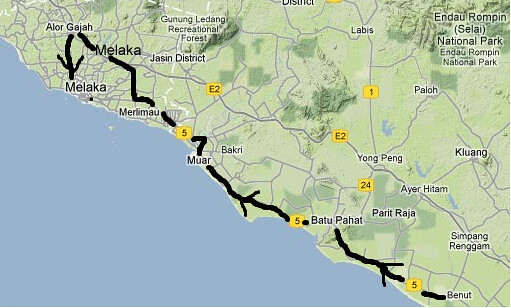 Excepting a few birds and bugs, we didn't really see that much in the way of wildlife as we rode, but the dog-sized carcasses of monitor lizards in the road left us in no doubt we were in a country packing some serious creatures. Tigers are no longer found around the inhabited areas of the peninsula, driven out by hunting and the destruction of their environment. This is of course a real shame, and it is deeply concerning that its remaining habitat is under severe strain. However, one has to bare in mind the dangers of tigers getting too close to people. In his account of the Malay peninsular in the mid nineteenth century, John Cameron recounts tales of the ferocity of tigers towards humans. In Singapore he claims that on average one person every day was killed by them, and he has many stories of villagers disappearing, being disembowelled or, perhaps a little unlikely, being entirely drained of blood by the beasts.
Excepting a few birds and bugs, we didn't really see that much in the way of wildlife as we rode, but the dog-sized carcasses of monitor lizards in the road left us in no doubt we were in a country packing some serious creatures. Tigers are no longer found around the inhabited areas of the peninsula, driven out by hunting and the destruction of their environment. This is of course a real shame, and it is deeply concerning that its remaining habitat is under severe strain. However, one has to bare in mind the dangers of tigers getting too close to people. In his account of the Malay peninsular in the mid nineteenth century, John Cameron recounts tales of the ferocity of tigers towards humans. In Singapore he claims that on average one person every day was killed by them, and he has many stories of villagers disappearing, being disembowelled or, perhaps a little unlikely, being entirely drained of blood by the beasts.If you want to avoid being gobbled up by a tiger there is an old Malay saying that can help you avoid this most unfortunate of incidents. To quote Cameron, who is quoting an old Malayan man he met: "If you will only speak to a tiger and tell it that it can get plenty of food in the jungle beside you, the animal will be persuaded, and leave you unmolested."
The reasoning behind this is not so airy-fairy as you might think. Cameron notes several eye-witness accounts of tigers turning and fleeing from people who turn to face them head on, and have the guts to raise their voice, or their blades at the animal. The problem with this method, as Cameron notes rather unhappily, is that tigers very rarely give you the chance to chat, as they sneak up behind you and do you in with a fatal first blow. One might also suggest that we can't take into account the number of people who tried to order the cat around, and failed, since they're no longer around to let us know how it went.
But anyway, I guess the point is that it is nice being able to mope around in southern Malaysia without worrying about getting engaged in life or death discussions with hungry tigers. However, what becomes glaringly obvious is the need for us to give them space, so they can get on with the business of being tigers without devouring us and getting in our bad books. The world would be a poorer place, no doubt, if we drive these truly awesome animals into extinction.
 |
| Tony's |
We were after some accommodation too, and after some getting lost Liv finally tracked down Tony's Guesthouse. This was recommended to us by www.travellingtwo.com, a fantastic website for would-be cycle tourers and one that has been an great help and inspiration for us. After all the support and morale boosting their website had offered us, it was nice to find their entry in the guest book from 2004, and feel a bit of a connection with other people crazy enough to go marauding around foreign countries on a bike.
Tony's was just cracking too. It was a three storey yellow building tucked away down a few roads near to the river. Tony has made this place feel very much like a home away from home, with all the walls painted bright happy colours, with paintings of animals and people on the walls and doors. Our room was no exception; bright and full of character, and it had a comfy bed and a balcony overlooking the red-roofscape outside.
 Which is not to say that other cultures weren't eminently apparent there either. Chinatown, which lay just across the river, was a giddy labyrinth of curling red roofs, lanterns, market stalls and temples. Just up the road from Tony's was the Indian influence, with a road full of shops selling sari's, spices and sundries. Every time we walked passed one shop the guy in there was blaring out Hindi music, livening the day up for for ten or so paces. At the main junction was a proper Indian restaurant too, which served an apparently unending combination of Indian dishes on banana leaves for a couple of dollars a head. Weekends saw the veggie special; no less than 12 dishes, plus rice, plus pappadums served up for 7 ringitt a head - which is just over $2, or a little under £1.50. We ate til it hurt at that place.
Which is not to say that other cultures weren't eminently apparent there either. Chinatown, which lay just across the river, was a giddy labyrinth of curling red roofs, lanterns, market stalls and temples. Just up the road from Tony's was the Indian influence, with a road full of shops selling sari's, spices and sundries. Every time we walked passed one shop the guy in there was blaring out Hindi music, livening the day up for for ten or so paces. At the main junction was a proper Indian restaurant too, which served an apparently unending combination of Indian dishes on banana leaves for a couple of dollars a head. Weekends saw the veggie special; no less than 12 dishes, plus rice, plus pappadums served up for 7 ringitt a head - which is just over $2, or a little under £1.50. We ate til it hurt at that place.The point that Melaka makes so abundantly clear with this mix of so many cultures, is that this is a place bursting with history, and I rather think, it serves as a good picking up point on our journey through some of the history of the Malays; complete with treachery, bloody battles, and a sunken horde of gold that readers at home can search for!*
*Disclaimer: you won't find it at home though, unless you live at the bottom of the sea off the coast of Sumatra.
The Melaka Mash
As you might have guessed by the disappearance of the Srivijaya empire from everybody's memories, there is not a great deal of hard evidence about what became of these people. Evidence remains in the form of ruins, and of myths passed down through the centuries. The kingdom seems to have slowly declined, until the pressures exerted by the Javanese kingdom of Majapahit became too much and it finally collapsed. Losing their capital on Sumatra, the leaders fled to try and continue their reign elsewhere. They wound up on a little island just off the south of the Malaysian mainland, which they called Temasek, but which was also known as Singapura. Yup, they had the same idea that Sir Stamford Raffles would have several centuries later, and thought this island a good place to try to start things anew.
Legend has it that one day the Malayan king of Singapura did something to disgrace one of his bed fellows. It seems this woman was very attractive, and the other concubines, who were jealous, started spreading nasty rumours about her. The king caught wind of these stories and decided to have her executed by being impaled. This method of capital punishment was considered very undignified, and the father protested, and asked that the king slay her in a more dignified manner. The king refused, and impaled she was. The woman's father was enraged by this and vowed to take revenge on the king. He colluded with the Majapahit empire (that's the Javanese one that caused them all the grief that made them all move in the first place), and invited them to come and invade the city. The city was well very protected at this time with a mighty wall, but the enemy had no difficulty getting their army inside since the father of the innocent, disgraced and impaled woman sneakily opened the main gates for them, and they piled in. Cue: bloody murder.
 Singapura fell, and The Malay king fled north, up the coast of the mainland where he found a river. He stopped to rest there with his dogs, so the legend goes, and there came prancing along a mouse deer. The dogs were keen to have this diddy bambi-like creature for their lunch, so they went for it, but the mouse deer defended itself bravely (not with Platonic reasoning, as far as I know). The king was very impressed by the bravery, and took it as a good omen of the weak overcoming the strong, so he decided to found his new empire there, in 1400.
Singapura fell, and The Malay king fled north, up the coast of the mainland where he found a river. He stopped to rest there with his dogs, so the legend goes, and there came prancing along a mouse deer. The dogs were keen to have this diddy bambi-like creature for their lunch, so they went for it, but the mouse deer defended itself bravely (not with Platonic reasoning, as far as I know). The king was very impressed by the bravery, and took it as a good omen of the weak overcoming the strong, so he decided to found his new empire there, in 1400.Melaka was a real source of pride for the Malays, a world renowned port attracting the attention of traders from Europe, India, Persia, Siam, China. Melaka's power and influence spread across the mainland, spreading Islam with it, and for a little over a hundred years everything seemed to be going very nicely for them there.
Unfortunately you don't set up such an amazing trading port without attracting some unwanted attention too, and the Portuguese set their sights on Melaka at the turn of the 16th century. After a failed first try, they successfully invaded and conquered the city in 1511. One must imagine, based on the account in the Malay annals, cannon balls raining into the town, musketeers charging, guns clattering "like peas in a sieve" and the Malayan rulers trying to repel the force on the back of their war elephants. Large mammals were no match for gunpowder though, and the leaders were forced to flee, and Melaka fell into the hands of the Portuguese.
As we ascended the hill in town one sunny afternoon, we came across the ruins of the old Portuguese fort, and the remains of their church. There's a nice view down to the sea from there offering a glimpse of what it would have been like seeing an armada bearing down on this quaint waterway in the tropics, since there's a life size replica of one of the ships down by the edge of the river, with its masts standing high above the rooftops.
 The replica is of the fabled Flor De La Mar, a ship that was involved in the cannoning of the town during the 1511 invasion. A testament to the motives of the Portuguese, as with most invasions, the Flor De La Mar was promptly loaded up with Melakan gold and jewels as soon as victory was declared, and was sent sailing back to Portugal. Unfortunately the captain had obviously not been paying attention to the reports of the ship springing leaks whenever she was heavily loaded. So they set sail anyway, heavily loaded with riches. No prizes for guessing what happened to her on the return journey. But, big prizes if you can figure out exactly where she floundered. Some say it is the richest vessel ever lost at sea, and the wreck has yet to be found.
The replica is of the fabled Flor De La Mar, a ship that was involved in the cannoning of the town during the 1511 invasion. A testament to the motives of the Portuguese, as with most invasions, the Flor De La Mar was promptly loaded up with Melakan gold and jewels as soon as victory was declared, and was sent sailing back to Portugal. Unfortunately the captain had obviously not been paying attention to the reports of the ship springing leaks whenever she was heavily loaded. So they set sail anyway, heavily loaded with riches. No prizes for guessing what happened to her on the return journey. But, big prizes if you can figure out exactly where she floundered. Some say it is the richest vessel ever lost at sea, and the wreck has yet to be found.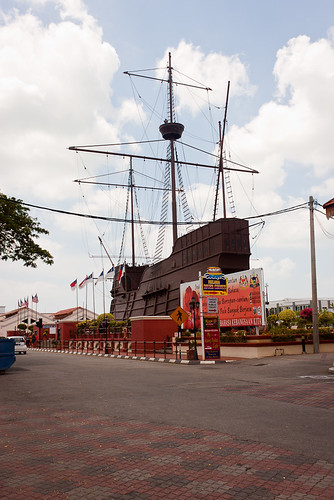 |
| Flor De La Mar |
Melaka changed hands a lot in the proceeding centuries. In 1641, with the help of the Malayan Sultan of Johor, the Dutch defeated the Portuguese and claimed Melaka as their own. Then they handed Melaka over to the British in 1824 in exchange for some of the places we had taken possession of in Sumatra. It seems that as time went by, and it was invaded, and possessed and repossessed, the draw it had once had for traders withered, so that by the time it became a crown colony under the British Empire, its days as a beacon for international trade were over.
It is, however, excellent as a place for travellers to relax in. And, if the desire or necessity should dictate, to have major dental work carried out.
Teeth
Dental care in Australia is not cheap, so it was with considerable dismay that I received news from my dentist six months ago that I needed two root canals re-doing, and it was going to set me back over $3000. It's bad enough being told that at any time, but at the time I was saving up for this cycling trip, and every penny counted, and every thousand dollars was even more precious than that.
I decided to take a gamble though, and wait it out a few months and get the work done in Malaysia instead. The initial plan had been Kuala Lumpur, but once we arrived in Melaka, and found the homely Tony's, and realised how pleasant the city was, we had a change of heart. We were enamelled by the place, to tell you the tooth, and decided to get the dental work done here instead.
Medical Tourism is commonplace in Malaysia. There are specific road signs pointing the way to international standard clinics and hospitals, and the medical centre in Melaka said in its blurb that it was designed to accommodate international patients' needs. Besides being able to go sunbathing after an operation, the attraction of getting yourself seen to abroad is, of course, the cost. $3000 in Australia for two root canals. Less than $800 in Malaysia. If I'd had the time to do so when I first got the news, it would have been cheaper for me to fly from Melbourne to Melaka, get the work done, have a two week break, and then fly back.
 Besides the concern that an abscess might creep up on my afflicted tooths while we were half way up a volcano in deepest darkest Java, I was of course somewhat concerned about quality since I'd be paying less than a third of the price for the service.
Besides the concern that an abscess might creep up on my afflicted tooths while we were half way up a volcano in deepest darkest Java, I was of course somewhat concerned about quality since I'd be paying less than a third of the price for the service.Only time will tell how good the work was, I suppose, but certainly my experience of root canal surgery in the tropics was a largely positive one. The medical centre was a large building, some ten stories high with a car park and glossy reception area. They had an annoying habit of making me register every time I came in for an appointment, which took a few minutes but only cost about 50p each time. The building itself was new, and clean, which was very reassuring. It was, to be quite honest, much cleaner and prettier than any hospital I've visited in the UK, and the dental department was as nice as any western dentist.
As far as having the work done, well, it was as pleasurable as having someone scrape the inside of your jaw out with a metal implement can be, but the dentist spoke fluent English, followed up the work with x-rays to check it was okay, and was informative whenever I asked about proceedings. Interestingly though, she only thought it prudent to fix up one of the teeth. The other, she said, was not so bad and it would be more hazardous to crack it open and give it a scrape, than to just leave it as it was but keep an eye on it. I was more than happy to take her word for that, and I wondered about the motives of my previous dentist, especially with so much money on the table.
 So, over the course of a week I had a few appointments and after registering I was seen to within 10 minutes on every occasion. The only hiccup was during an especially important x ray. My tooth was decapitated, and had a number of metal screws and implements poking out of it while the dentist worked at scraping out any infection from the root canals. One of the canals was remaining stubbornly hidden from view though, and she couldn't find the dam thing! Only one thing for it then, an x-ray to find out where it was lurking. I was led, mouth agape with apparatus hanging out of it into the x-ray room. The machine was lined up, the lead jacket was put on, and the dentists retreated to push the button and - CLICK! Everything went pitch black. The machine had blown a fuse and powered out the whole floor, leaving everyone in darkness. The x-ray machine down, the dentist had to just keep on prodding around to find it once the power came back on some 15 minutes later. She found it though, eventually.
So, over the course of a week I had a few appointments and after registering I was seen to within 10 minutes on every occasion. The only hiccup was during an especially important x ray. My tooth was decapitated, and had a number of metal screws and implements poking out of it while the dentist worked at scraping out any infection from the root canals. One of the canals was remaining stubbornly hidden from view though, and she couldn't find the dam thing! Only one thing for it then, an x-ray to find out where it was lurking. I was led, mouth agape with apparatus hanging out of it into the x-ray room. The machine was lined up, the lead jacket was put on, and the dentists retreated to push the button and - CLICK! Everything went pitch black. The machine had blown a fuse and powered out the whole floor, leaving everyone in darkness. The x-ray machine down, the dentist had to just keep on prodding around to find it once the power came back on some 15 minutes later. She found it though, eventually.I had that troublesome tooth seen to then, and got a new crown to replace an old one. The bill came in at a little under $500 for the two things, including x-rays, injections, and registration fees. Provided the treatment is successful, and so far it seems to be fine, I would say it was well worth me waiting.
 |
| Melaka's famous night market is great fun but even more so when you're pissed on gin |
We ended up spending 3 weeks in Melaka, it was a very difficult place to leave. The dental work took about ten days in total, but on the day of the last appointments our Christmas presents arrived from home: two e-book readers. Thoroughly settled in by this point, and now with a whole world of books opened up to us, it was all too easy to sit back and relax even more.
Each weekend the main lane in China town comes alive with stalls, noise and smells to herald the weekend market. We went back there again and again, our first outing being a blur after we got a bit carried away drinking gin before we left, and the second time witnessing the most incredible piece of entertainment known to humankind. It was karaoke on a grand stage constructed at a junction in the road. A sizeable crowd was gathered, and on stage various people came forth to sing into the microphone, while two dancers pranced around them in a truly hypnotic fashion.
One was a woman apparently apparently just dragged from a meal alone to grieve a recent break up, who shuffled forlornly from side to side wearing an expression of catatonic despair. Contrasted against this woeful figure was a old guy in a bright yellow sparkling jumpsuit, with a red bow-tie and a dyed crop of black hair, who stretched and writhed his lanky limbs like an elderly family member dancing at a wedding, but with all the careful precision of an eager young ballerina. They say that travel lets you experience things you never usually would, and I can tell you, hand on heart, I don't think we'll ever witness such a... captivating dance performance as that. And if we do, we probably won't be eating an octopus on a stick, as we were when all this was going on.
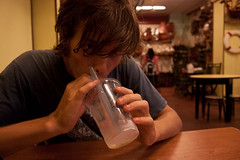
 Time was getting on though, and we finally got our things packed up and left on the 1st March. Tony gave us a free breakfast of beans on toast and coffee, and wished us good luck as we took to our bikes once again. They felt very strange, they always do when we've been off them for a while. The handlebars feel loose, and the weight always feels lopsided. So we took it easy, slowly pedalling through the town, over the bridge, down the market lane and back onto the hot, flat, dry main road along the coast towards the country's capital; Kuala Lumpur.
Time was getting on though, and we finally got our things packed up and left on the 1st March. Tony gave us a free breakfast of beans on toast and coffee, and wished us good luck as we took to our bikes once again. They felt very strange, they always do when we've been off them for a while. The handlebars feel loose, and the weight always feels lopsided. So we took it easy, slowly pedalling through the town, over the bridge, down the market lane and back onto the hot, flat, dry main road along the coast towards the country's capital; Kuala Lumpur.
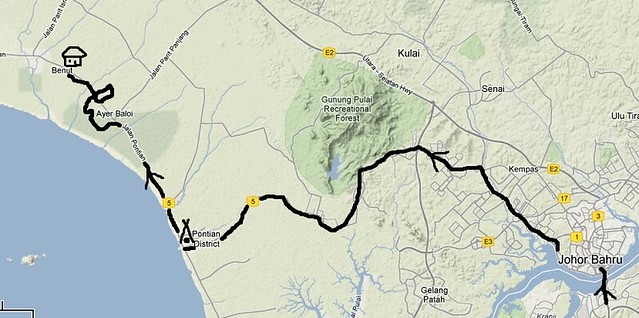
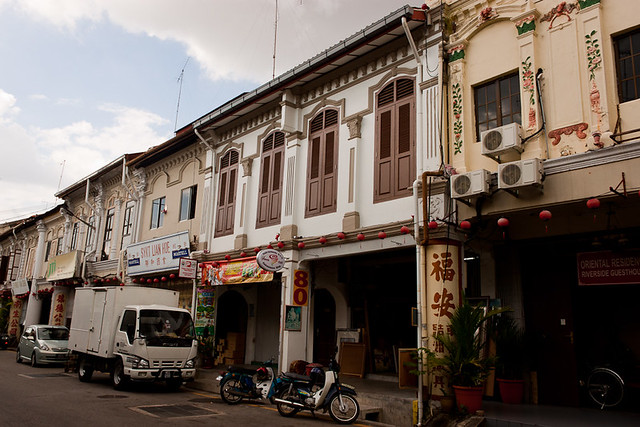


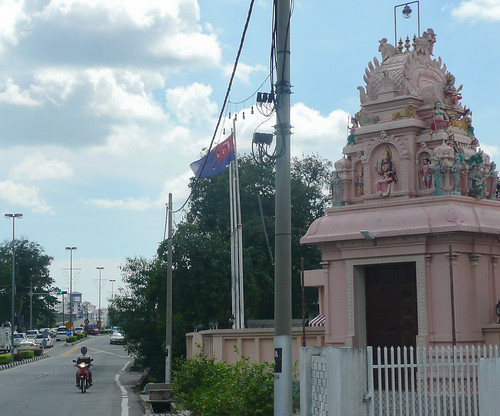
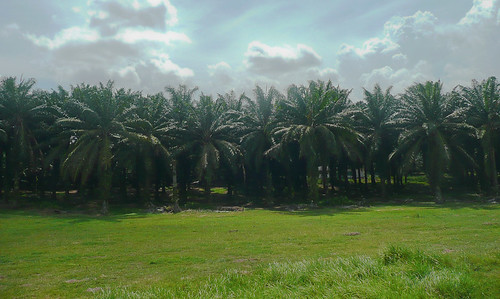
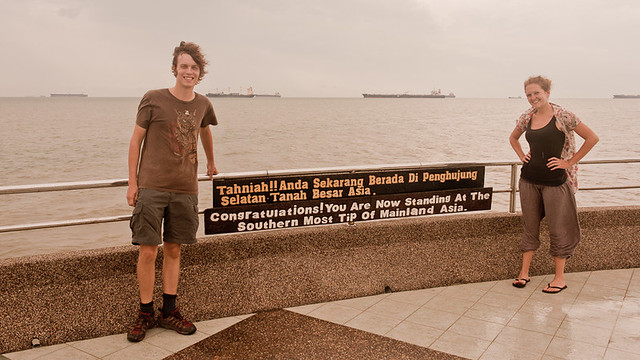

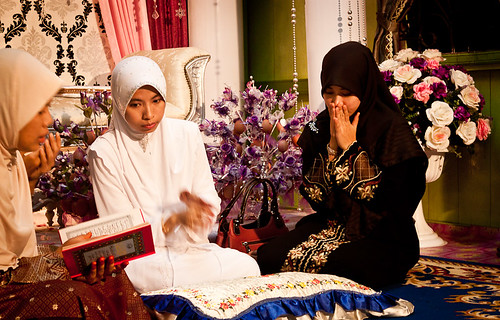
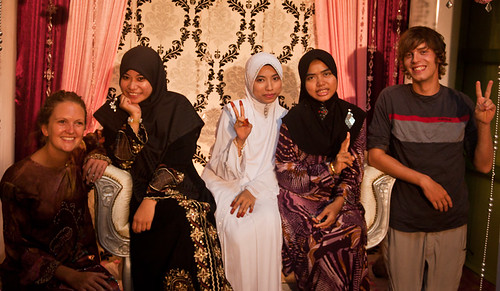

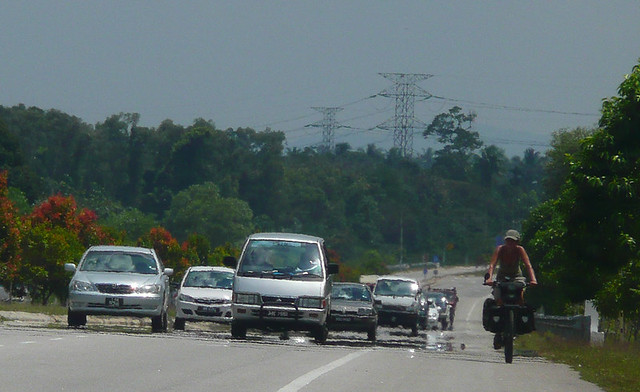

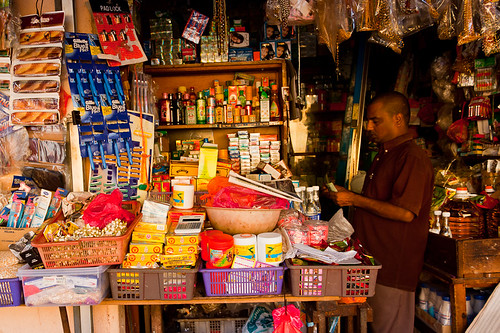
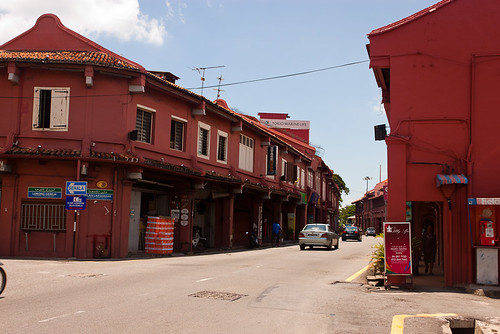
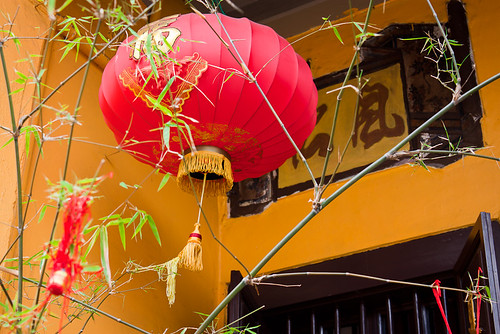



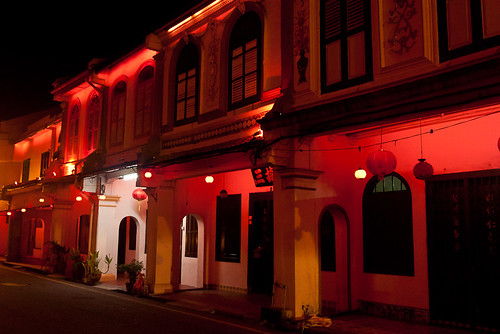
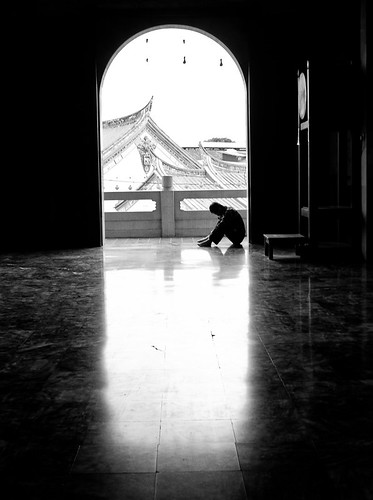
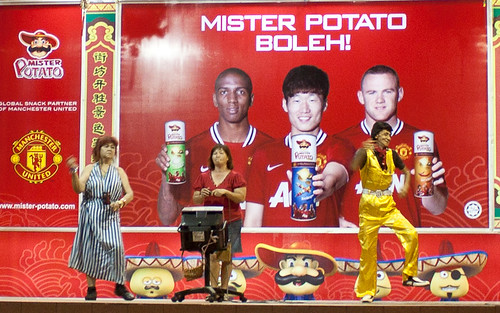
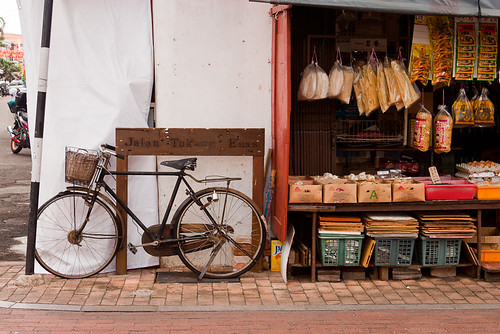
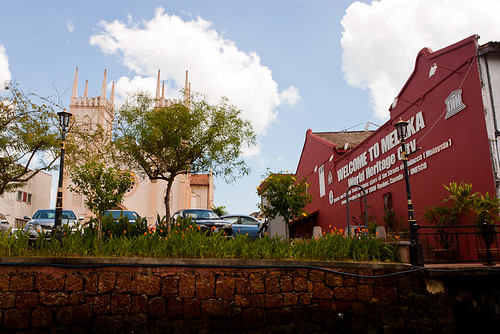
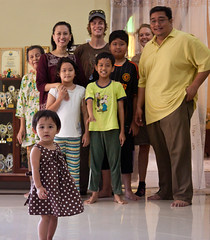


Hey you guys
ReplyDeleteHope you are both well and were not to freaked out by the earthquake yesterday. Richie and I both felt it, was scary. We got the ferry across to Langkawi today. Due to head to Koh Lanta tomorrow.
Looking forward to hearing how you guys are getting on.
Sophia & Richie